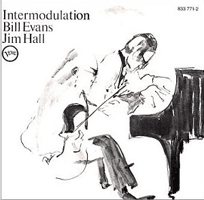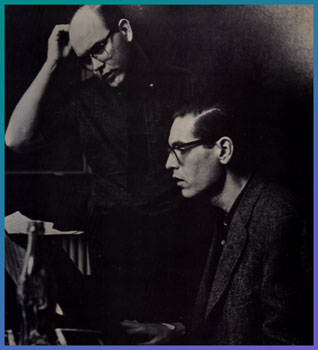

|
Soundclip:
|
| See Steve's Hand-Written Solo
Transcription |
|
Jim Hall's solo on: "I've Got You Under My Skin"(Cole Porter) When Bill Evans and Jim Hall originally recorded "UNDERCURRENT"(Blue Note) in the Spring of 1962, there was no question about the fact that it was a work of lasting beauty by these two masters of melody, harmony, and improvisational development. Add to that their great musical dignity, it would have been a great, great shame had they never recorded together again.  And so, ironically, in the Spring of 1966, they enter Rudy Van Gelder's studio and recorded "INTERMODULATION"(Verve). Both recordings embrace the great American Songbook by covering standards from Gershwin, Rodgers & Hart, Ned Washington, and Van Heusen & Burke. Here, I've selected Hall's solo over Cole Porter's "I've Got You Under My Skin" for presentation and analysis. And so, ironically, in the Spring of 1966, they enter Rudy Van Gelder's studio and recorded "INTERMODULATION"(Verve). Both recordings embrace the great American Songbook by covering standards from Gershwin, Rodgers & Hart, Ned Washington, and Van Heusen & Burke. Here, I've selected Hall's solo over Cole Porter's "I've Got You Under My Skin" for presentation and analysis.What is possibly most curious about this particular performance is that it commences with Jim Hall's one chorus guitar solo, which is followed by Bill Evan's one chorus piano solo and then, after that, the melody is finally stated. I have no particular historical information about the recording of this tune, but when there are two players with such a great love and respect for melodies, it is hard to believe that they would not have stated it first. On the other hand, they would have certainly been fearless about taking a different approach and perhaps agreeing to structure the piece as it now appears. However, it is also possibly, though it would have offered a technological challenge, as editing was a more complex feat with tape then; and that is, they might have begun by playing the melody but after listening back, perhaps it was, on some level, flawed and they all decided to simply edit it out. Strange, but possible. This particular Cole Porter standard has its own oddities which makes labeling the form a bit tricky. Written in cut-time, you have a 16-bar [A] section followed by a 16-bar [A2] section. These sections are followed by what I have chosen to label as a [B] section, which could also be seen as having 16-bars. However, there is also a little [Tag] to the [B] which I chose to label as [A3] as it does, at the very least, repeat the title phrase, "I've Got You Under My Skin." One of the more fascinating aspects of their performance is that Jim Hall plays a different set of changes under Bill Evans' solo and under the melody than what Bill Evans plays in support of Jim's solo. Hall executes his accompaniment in this context by, most likely, having his Gibson ES-175 mic'ed while he comps in a Freddie Green-esque style. A perfect example of this would be if you compare these changes, played by Jim Hall from bars 1-4 of [A] with the ones which I have labeled that Bill Evans plays on the transcription. Another interesting example of this takes place during bars 9-12 of [B] where Hall employs a nice descending bass line: Again, it is important that you contrast this with the changes Bill Evans is using. It's remarkable that both approaches work. But I would imagine that this was something that they would have discussed beforehand, because too much respect must have existed between these two great masters. Jim Hall's one chorus solo is fundamentally very diatonic as many of the ii-V-I passages to Ebmaj are approached with melodic content derived from the Eb major scale. You can hear this during [A] in bars 1-3, 7-8, 9-11, 12-16; during [A2] 1-4, 9-12(a ii-V to C major), and 13-15(ii-V to Eb major); and in [B] in bars 1-7. If we look a little closer at [A], with his usage of the Cb the b5 of F-minor, it's almost as if he is playing the change which appears, in reality, at [A2].  One of the most important elements in negotiating any set of 'turnaround' changes is how you observe the VI7 chord, in this case C7(alt.). In bar 4, Hall marks the change with a Db, and in bar 12, he uses the more traditional language when traveling down from another Db via a slur to an E-natural which most clearly says C7 to everyone. In general, one of the most traditional devices, especially over any iim7 chord(in this case, Fm7), is the usage of the major 7th degree(E-natural). You can see that Hall employs this device during [A] at bar 9, and then one last time during [B] at bar 13. One of the most important elements in negotiating any set of 'turnaround' changes is how you observe the VI7 chord, in this case C7(alt.). In bar 4, Hall marks the change with a Db, and in bar 12, he uses the more traditional language when traveling down from another Db via a slur to an E-natural which most clearly says C7 to everyone. In general, one of the most traditional devices, especially over any iim7 chord(in this case, Fm7), is the usage of the major 7th degree(E-natural). You can see that Hall employs this device during [A] at bar 9, and then one last time during [B] at bar 13.As it would be in any Jim Hall improvisation, there are always going to be elements of the development of his ideas, both melodically and rhythmically. A prime example of this would be the passage at [B] where he employs all the repeated notes. But, it is interesting to note the little conluding portion of the phrase in bar 3 and bar 11 of [A]. And this idea, both melodic and rhythmic appears again in [A2] during bars 7, 11, and 15. He also develops a nice idea during [A] from bars 12-16. As I try to do during most of the Hall solos analyzed here, I want to point out his usage of legato phrasing via the elimination of picked strokes. Phrases to take note of occur during: [A] in bars: 9-12; [A2] bars 5-15; [B] bars 12-16; [A3] bars 5-6. In addition to these passages, I want to point out where Jim employs a 'blues' mannerism or phrase in bars 1-2 of [A3] because it is a most common Jazz device over a diminished chord when it appears as this particular A°7 chord does in bar 2 after the Fm7. And finally, from the guitar perspective, you might want to investigate the various little 'sweeps' that Jim uses, and they appear during [A2] in bars 8-10. And so, we happily welcome the arrival of Spring '07 with this posting. There will be no "Aprils Fools Day" jokes! Just enjoy this transcription with our best wishes for a beautiful Spring season wherever you might be. We are looking forward to beautiful things during the Summer too!!! So, while you're at it, try to do something nice for someone each day!!!
[Photo of Jim Hall & Bill Evans]
|